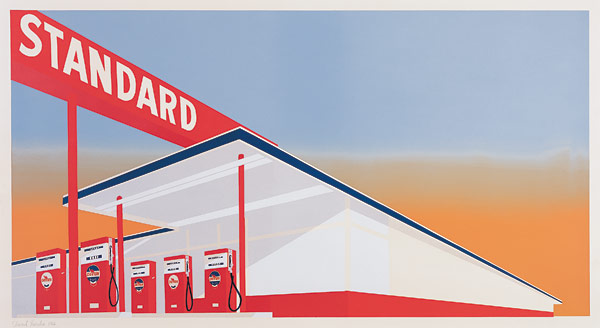
Perspective, in a nutshell, is how much space/distance is shown in a 2D space or surface. A shallow perspective is just that, a perspective that is not very deep or flat. Think cave paintings or Egyptian hieroglyphs. Those are classic examples of shallow perspective. It was the Romans that eventually figured out how to create the illusion of three-dimensional space on a 2D surface. The house paintings in Pompeii are amazing examples of the Romans creating a sense of recession into space or what we would call one-point and two-point perspective.
After the fall of Rome, this skill or knowledge was lost, but If we fast forward through the Middle Ages (a time of generally flat art) to the Renaissance, it gets rediscovered. Most people argue it was Brunelleschi (1377-1446) who figured it out by drawing the famous Baptistery in Florence, using a mirror to figure out where the perspective lines go. We call this mathematical perspective today because it can also be described in numbers and geometry as well as art. Once the trick of expressing 3D images on a 2D surface was figured out, it became a mainstay of the arts until the late 19th and early 20th century when our modern art forefathers and mothers said…”Hey, let’s flatten out space again, cave painting is way more exciting. This 3D perspective trick is just a visual lie.” Once you master the technique of perspective and learn its tricks, it becomes second nature. If you can write your name you can draw!
Types of perspective in art:
-
Flat
Just like it says, flat perspective makes no attempt at creating any illusion of depth.
- Ancient Egyptian painting
- Ad Reinhardt's Abstract Painting
- Piet Mondrian's Broadway Boogie Woogie
- Keith Haring's Red Room
-
Shallow
Shallow perspective makes an attempt at creating an illusion of depth
- Lorenzo Ghiberti's Gates of Paradise
-
Foreshortening
Objects that are close by are large, and ones that are further away are smaller depending on how far away they are.
- Katsushika Hokusai's The Great Wave off Kanagawa
- Katsushika Hokusai's A Tour of the Waterfalls of the Provinces: The Falling Mist Waterfall at Mount Kurokami
- Andrea Mantegna's Lamentation of Christ
-
Linear
Use a ruler and pick a point (or points) on the horizon. This is what is known as the "vanishing point", and it's where all the lines will converge.
Single Point
- Leonardo Da Vinci's The last Supper
- Ed Ruscha's Hollywood
- Wayne Thiebaud's San Francisco West Side Ridge
Two Point
- Staircase in Two Point Perspective
- Giovanni Battista Piranesi's The Colosseum
Three point
- Cube in three Point Perspective
- Ed Ruscha's Standard Station
- Giovanni Battista Piranesi's Prison
Multiple point
- M.C. Escher's Ascending and Descending
Overhead
- James Dooling's Shopping Mall
-
Warped/Curvilinear
Throw out your ruler.
- Deborah Oropallo's Amusement
- Alex Grey's Gaia
- Bridget Riley's Hesitate
- Wassily Kandinsky's Murnau, Burggrabenstrasse 1
- Kiki Smith's My Blue lake
- Salvador Dali's The Persistence of Memory
- Vincent van Gogh's The Starry Night
-
Atmospheric
Objects that are close by are vivid in color, and objects that are far away are faded.
- Frank Stella's Letter on the Blind II
- J.M.W. Turner's Helvoetsluys; the City of Utrecht, 64, Going to Sea
-
Insane
There are no rules, or the rules are so complicated that no one understands them.
- Richard Wilson's 20:50
- Julio LeParc's Instability. Architectural Proposition
For further information, check out this video by Dan Beardshaw about how to draw perspective. Another excellent resource on perspective is the "Perspective Drawing Handbook" by Joseph D'Amelio, which you can find on Amazon here.
This reader is part of a larger series of introductory texts about art and art history. Each has been written under the direction of Rick Love. This reader was co-authored by Francisco Serrador.
Comments (2)

I never realized that cave paintings and Egyptian hieroglyphs were great examples of shallow perspective; I honestly thought they were just a flat art in their own category. I also never knew that it was the Romans who figured out how to draw 3D art! I find it fascinating how the 3D ability was lost after the fall of Rome until around the time of Brunelleschi’s “Baptistry in Florence” painting. I also find it funny how after rediscovering the 3D imaging people decided to go back to flat imaging. I appreciate the perspectives in art list; these images are interesting to look at and the definition of what perspective they are gives a slightly better understanding of the image to me.










Perspective is something I've given literally no thought to until my art history class showed me how to break down a painting.